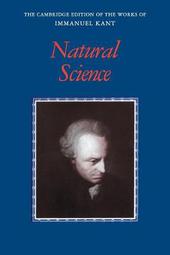
|
Kant: Natural Science
Paperback / softback
Main Details
Description
Though Kant is best known for his strictly philosophical works in the 1780s, many of his early publications in particular were devoted to what we would call 'natural science'. Kant's Universal Natural History and Theory of the Heavens (1755) made a significant advance in cosmology, and he was also instrumental in establishing the newly emerging discipline of physical geography, lecturing on it for almost his entire career. In this volume Eric Watkins brings together new English translations of Kant's first publication, Thoughts on the True Estimation of Living Forces (1746-9), the entirety of Physical Geography (1802), a series of shorter essays, along with many of Kant's most important publications in natural science. The volume is rich in material for the student and the scholar, with extensive linguistic and explanatory notes, editorial introductions and a glossary of key terms.
Author Biography
Eric Watkins is Professor in Philosophy at the University of California, San Diego. He is author of Kant and the Metaphysics of Causality (Cambridge, 2005), editor of Kant and the Sciences (2001) and translated and edited Kant's Critique of Pure Reason: Background Source Materials (Cambridge, 2009).
Reviews'... this volume is a much-needed, very valuable contribution to scholarship. It brings together important texts by an important philosopher, readably translated and edited to the highest standards in the field. It will easily become the new reference work on Kant's natural-scientific output and will foreseeably remain the standard text for decades to come.' Metascience 'The value of this publication is conspicuous given that it brings together Kant's specialised works on natural science and makes them available in English translation, some of them even for the first time ... this volume can be extremely helpful for historians of astronomy and Kant scholars who are interested in assessing the extent to which Kant influenced his contemporaries and immediate successors.' Silvia De Bianchi, Journal for the History of Astronomy
|